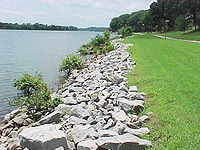
Riprap
Encyclopedia


Rock (geology)
In geology, rock or stone is a naturally occurring solid aggregate of minerals and/or mineraloids.The Earth's outer solid layer, the lithosphere, is made of rock. In general rocks are of three types, namely, igneous, sedimentary, and metamorphic...
or other material used to armor
Armor (hydrology)
Armor, in hydrology and geography is the association of surface pebbles, rocks or boulders with stream beds or beaches. Most commonly hydrological armor occurs naturally; however, a man-made form is usually called riprap, when shorelines or stream banks are fortified for erosion protection with...
shore
Shore
A shore or shoreline is the fringe of land at the edge of a large body of water, such as an ocean, sea, or lake. In Physical Oceanography a shore is the wider fringe that is geologically modified by the action of the body of water past and present, while the beach is at the edge of the shore,...
lines, streambeds, bridge abutments, pilings and other shoreline structures against scour
Bridge scour
Bridge scour is the removal of sediment such as sand and rocks from around bridge abutments or piers. Scour, caused by swiftly moving water, can scoop out scour holes, compromising the integrity of a structure....
, water or ice erosion.
It is made from a variety of rock types, commonly granite
Granite
Granite is a common and widely occurring type of intrusive, felsic, igneous rock. Granite usually has a medium- to coarse-grained texture. Occasionally some individual crystals are larger than the groundmass, in which case the texture is known as porphyritic. A granitic rock with a porphyritic...
or limestone
Limestone
Limestone is a sedimentary rock composed largely of the minerals calcite and aragonite, which are different crystal forms of calcium carbonate . Many limestones are composed from skeletal fragments of marine organisms such as coral or foraminifera....
, and occasionally concrete rubble from building and paving demolition. It is used to protect coastlines and structures from erosion by the sea, rivers, or streams. It can be used on any waterways or water containment where there is potential for water erosion.
Protection mechanism
Riprap works by absorbing and deflecting the energy of waves before they reach the defended structure. The size and mass of the riprap material absorbs the impact energy of waves, while the gaps between the rocks trap and slow the flow of water, lessening its ability to erode soil or structures on the coast. The mass of riprap also provides protection against impact damage by ice or debris, which is particularly desirable for bridge supports and pilings.It is frequently used to protect the base of old Edwardian and Victorian sea walls, which being vertical are often undermined. The riprap absorbs the impact of the waves as they shoot up the wall and then fall back down.
In the Western United States, riprap can also mean a boring and not worthy.
See also
- Erosion controlErosion controlErosion control is the practice of preventing or controlling wind or water erosion in agriculture, land development and construction. Effective erosion controls are important techniques in preventing water pollution and soil loss.-Introduction:...
- Riparian zoneRiparian zoneA riparian zone or riparian area is the interface between land and a river or stream. Riparian is also the proper nomenclature for one of the fifteen terrestrial biomes of the earth. Plant habitats and communities along the river margins and banks are called riparian vegetation, characterized by...
- RevetmentRevetmentRevetments, or revêtements , have a variety of meanings in architecture, engineering and art history. In stream restoration, river engineering or coastal management, they are sloping structures placed on banks or cliffs in such a way as to absorb the energy of incoming water...
- Accropode
- Baer's lawBaer's lawIn geology, Baer's law, named after Karl Ernst von Baer, says that, because of the rotation of the earth, in the Northern Hemisphere, erosion occurs mostly on the right banks of rivers and in the Southern Hemisphere on the left banks...
- Construction aggregateConstruction AggregateConstruction aggregate, or simply "aggregate", is a broad category of coarse particulate material used in construction, including sand, gravel, crushed stone, slag, recycled concrete and geosynthetic aggregates. Aggregates are the most mined material in the world...
- Dimension stoneDimension stoneDimension stone is natural stone or rock that has been selected and fabricated to specific sizes or shapes. Color, texture and pattern, and surface finish of the stone are also normal requirements...
- LimestoneLimestoneLimestone is a sedimentary rock composed largely of the minerals calcite and aragonite, which are different crystal forms of calcium carbonate . Many limestones are composed from skeletal fragments of marine organisms such as coral or foraminifera....
- Bridge scourBridge scourBridge scour is the removal of sediment such as sand and rocks from around bridge abutments or piers. Scour, caused by swiftly moving water, can scoop out scour holes, compromising the integrity of a structure....
- Hudson's equationHudson's equationHudson's Equation, also known as Hudson's Formula, is an equation used by coastal engineers to calculate the minimum size of riprap required to provide satisfactory stability characteristics for rubble structures under attack from storm wave conditions.The equation was developed by the United...
- TetrapodTetrapod (structure)In coastal engineering, a Tetrapod is a four-legged concrete structure used as armour unit on breakwaters. The Tetrapod's shape is designed to dissipate the force of incoming waves by allowing water to flow around rather than against it, and to reduce displacement by allowing a random distribution...

